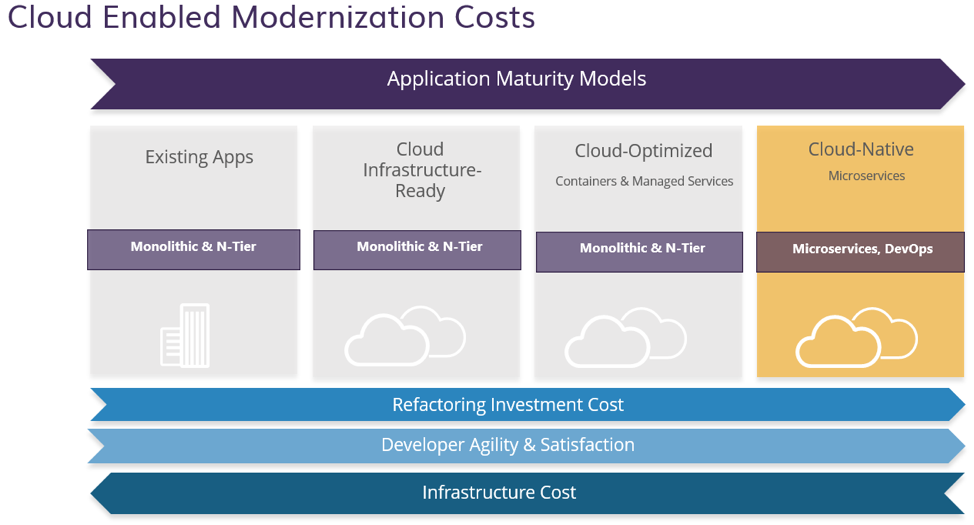Government organizations have an opportunity to transform through cloud migration as they navigate what’s next in technology.
Like their counterparts in industry, the pandemic accelerated the cloud migration plans of government agencies. Cloud’s compelling business cases regarding scalability and reliability took on a new urgency due to the pandemic.
Agencies had to adapt quickly to accommodate a deluge of unemployment requests, escalating contact tracing activities and broad citizen engagement initiatives.
While the cloud’s scalability and reliability proved vital to accomplishing those tasks, there are numerous other benefits of cloud adoption within government agencies, particularly around the modernization of legacy applications. Here are a few:
1. Improve Efficiency and Realize Cost Savings by Modernizing Legacy Applications
Legacy applications can hamper even the best of intentions. Managing technical debt can be costly and time-consuming, distracting you from more important citizen-impacting initiatives. The beginning of cloud migration is the perfect time to re-evaluate your application footprint.
A common first step is to review your applications through the lenses of the 6 R’s — Remove, Retain, Replatform, Rehost, Repurchase, and Refactor. This rubric is a good way to sort and prioritize your legacy applications for a cloud migration. We even recommend going a step further and also considering the 5 W’s.
From there, you need to make decisions regarding how “modern” to make your legacy applications. There are no right or wrong answers, just what is right for your timeline, budget and team knowledge.
For instance, a complete refactoring leveraging microservices will make your application nimbler and more cost-effective from an infrastructure standpoint. However, you could have significant refactoring costs depending on your starting point, and you may have challenges supporting it with your team’s existing skillset. Depending on your situation, you may want to choose a more intermediary step, such as a lift-and-shift approach using containers.
2. Increased Employee Satisfaction Thanks To Modern Development Practices
The impending departure of Baby Boomer aged employees in public service due to retirement, also known as the “Silver Tsunami,” is at the front of many people’s minds. Their departure leaves a considerable knowledge loss.
However, this workforce attrition can also serve as an opportunity. As discussed in the last point, refactored legacy applications are easier to maintain. Thus, the risk associated with employee departure lowers as you transfer application maintenance knowledge between employees with more ease.
Another benefit is that candidates are attracted to the prospect of working with the latest technologies. It is much easier to convince a new college grad to develop cloud-based software with serverless architecture than it is to maintain monolithic legacy applications.
Add in modern best practices such as fully automated testing, Continuous Integration and Deployment practices, and agile methodologies to see your developer agility and satisfaction skyrocket.
3. Serve Your Citizens in Innovative Ways Using Your Cloud Foundation
Having a cloud foundation is essentially table stakes for implementing innovative services for your citizens. Cloud allows your organization to capture and process more data. You can then leverage building blocks, making development more efficient. More efficiency means more time for the value-add work that leads to new ideas. Those new ideas give rise to prototypes, which you can spin up and out much faster. And as your innovation gathers speed, the cloud scales easily with your growth.
A few cloud-enabled examples of citizen-focused initiatives:
- Internet of Things (IoT) – As the popular saying goes, “you can’t manage what you can’t measure.” IoT allows municipalities to better monitor everything from traffic lights to trash disposal.
- Digital Engagement – Citizens are coming to expect omnichannel accessibility in all facets of their life. Cloud enables the increased ability to connect to your constituents via chatbots, SMS, email and even virtual reality.
- Machine Learning – With increased calls for governmental efficiency, machine learning provides a novel way to sort through your existing data to find new operational insights. Recent advancements in cloud-based tools make machine learning far more accessible to implement in the public sector.
Conclusion
Both the private and public sectors accelerated cloud migrations during the pandemic. The practicality of being able to scale as needed while also managing a reliable, secure environment is rapidly become an operational necessity. However, organizations can truly harness the cloud’s power when they also look to modernize their legacy applications.
Gaining agility while also better serving your employees and citizens turns a cloud migration into an organizational transformation.



